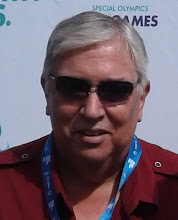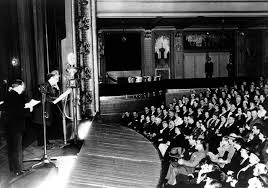The Brush Cut Meets The Old Schnozzola: The Way It Was, 25 March
1943---A gravelly singer-comedian with a cheerfully anarchic stage act, a gleefully unapologetic genius for turning the King's English (not to mention the Queens, the Bronx, the Staten Island's, and the Manhattan's) into the most magnificent menagerie of malaprops this side of Jane Ace, and a slightly fading image (believe it or not), gets a huge break when Camel Comedy Caravan producer Phil Cohan teams him with a genial young comic who's hosted a couple of game shows (Beat the Band and Everything Goes in particular)---and the pair clicks almost from the moment they premiere on NBC tonight.
Jimmy Durante and Garry Moore prove viable enough (with Moore himself providing a decent share of the show's writing) that---long after the show's name is changed to The Durante-Moore Show---they split only when Garry Moore leaves to take over as the host of the popular Take It or Leave It in 1948, launching him toward hosting his own more successful Garry Moore Show on radio and television.
Some will suggest Durante never has it better on radio (at least, until he becomes a semi-regular guest on Tallulah Bankhead's The Big Show, including its premiere edition) than when he had Moore's easygoing style (Dat's my boy what said dat! becomes a near-instant catch phrase) as a contrast to his tough-but-tender malapropriety and music and self-mocking style. ("I got dat note from Bing---and, boy, was he glad to get rid of it!")
When Moore leaves to strike back on his own, Durante's sidekick will become the less effective Alan Young---and Durante's career as a radio host in his own right (the show's name is changed to The Jimmy Durante Show) doesn't last much longer den dat.
His legend, however, is something else entirely . . .
Durante was pure, complete, unabashed entertainer, a man possessed with the desire to please at all costs; and he aged beautifully, unlike many entertainers, never wearing out his welcome. The very idea of a man who sounded like Durante actually singing, in that ramshackle voice, was enough to make anybody laugh . . . Even now, especially now, he seems like an unlikely and wholly remarkable character, a Bowery leprechaun who captivated every audience he ever faced---or didn't face. The critic Gilbert Seldes got it about right when he wrote that Durante "offers himself where others exploit themselves. [He] communicates so unfailingly the laughter that rises out of love." Nobody was ever remotely like him.---Gerald Nachman, in "Vaudio," from Raised on Radio. (New York: Pantheon Books, 1998.). . . He's dynamite in his sleep. On the stage, before the sound cameras, in front of the mike, he is a clown without peer. And he carries his artistic madness beyond those regions where it means money in his kilts . . .Jimmy talks and behaves off stage in the helter-skelter fashion he performs before a theater audience. He strides up and down and flails his arms about. He mispronounces words as words have never been mispronounced before. And when he suddenly meets up with some famous personality whose greatness borders on sacred he is a lady monkey on wheels.One day Jimmy stepped into the elevator at the Astor and found himself in the august presence of Arturo Toscanini. The Beak of Broadway removed his hat, bowed from the waist, and said:"Masstro, howja do! My name's Schnozzola Durante, an' I'm in show business too."Toscanini acknowledged this unusual self-introduction with a slight bow and no words."Facta th'matter is," continued Jimmy, unabashed, "I wrote me a song about you, Masstro.""Good?" asked Toscanini."Dynamite!" Jimmy assured him. "It's gotta title, 'Toscanini, Stokowski, an' Me'.""You compare us?""Compare us!" roared Durante. "Soitenly, I compares us. I compares you two boys ta me, an' I comes out best."Toscanini seemed amused, so Jimmy gave out with a few lines from his song---the part where he picks up da paper' and sees a pitcha of Toscanini, Stokowski, an' himself an' immediately exclaims: "Who is dem two guys, anyway, gettin' mention wid me?"---H. Allen Smith, "All Nose," from Low Man on a Totem Pole. (New York: Doubleday & Doran, 1941, 1944.)
CHANNEL SURFING . . .
1935: LOSING MONEY ON THE CIRCUS---Listening to Squire's mistaken crowd predictions and trying to finance it by way of the store teaches Lum (Chester Lauck, who also plays Grandpap) a hard lesson, after the circus's grand opening shows a forty-dollar loss and Abner (Norris Goff, who also plays Squire) may have miscounted some of the circus opening's tickets, on tonight's edition of Lum & Abner. (CBS.) Writers: Chester Lauck, Norris Goff.
1940: REMEMBER THE NIGHT---Barbara Stanwyck and Fred MacMurray reprise their hit film roles as a shoplifter (Stanwyck) whose prosecutor (MacMurray) postponed her trial rather than let it clash with Christmas gets a break when he helps arrange her bail . . . and they fall in love, potentially compromising the coming trial, on tonight's edition of Lux Radio Theater (CBS), which seems to have had the occasional habit of airing Christmas-tied stores in the early months following Christmas. Additional cast, also repeating their film roles: Elizabeth Patterson, Beulah Bondi, Sterling Holloway.
PREMIERING TODAY . . .
1867---Arturo Toscanini (conductor: The NBC Symphony Orchestra), Parma, Italy.
1887---Raymond Gram Swing (commentator: CBS), Cortlandt, New York.
1892---Andy Clyde (actor: Hopalong Cassidy), Blaingowrie, Scotland.
1901---Ed Begley, Sr. (actor: Richard Diamond, Private Detective), Hartford, Connecticut.
1903---Binnie Barnes (panelist: Leave It to the Girls, Breakfast with Binnie and Mike), London.
1908---Philip Reed (actor: Society Girl, David Harum), New York City.
1916---Jean Rogers (actress: Those We Love), Belmont, Massachussetts.
1919---Jeanne Cagney (actress: Movietone Radio Theatre, Suspense), New York City.
1921---Nancy Kelly (actress: Cavalcade of America, Suspense), Lowell, Massachussetts.
1887---Raymond Gram Swing (commentator: CBS), Cortlandt, New York.
1892---Andy Clyde (actor: Hopalong Cassidy), Blaingowrie, Scotland.
1901---Ed Begley, Sr. (actor: Richard Diamond, Private Detective), Hartford, Connecticut.
1903---Binnie Barnes (panelist: Leave It to the Girls, Breakfast with Binnie and Mike), London.
1908---Philip Reed (actor: Society Girl, David Harum), New York City.
1916---Jean Rogers (actress: Those We Love), Belmont, Massachussetts.
1919---Jeanne Cagney (actress: Movietone Radio Theatre, Suspense), New York City.
1921---Nancy Kelly (actress: Cavalcade of America, Suspense), Lowell, Massachussetts.












0 Comments:
Post a Comment
Subscribe to Post Comments [Atom]
<< Home